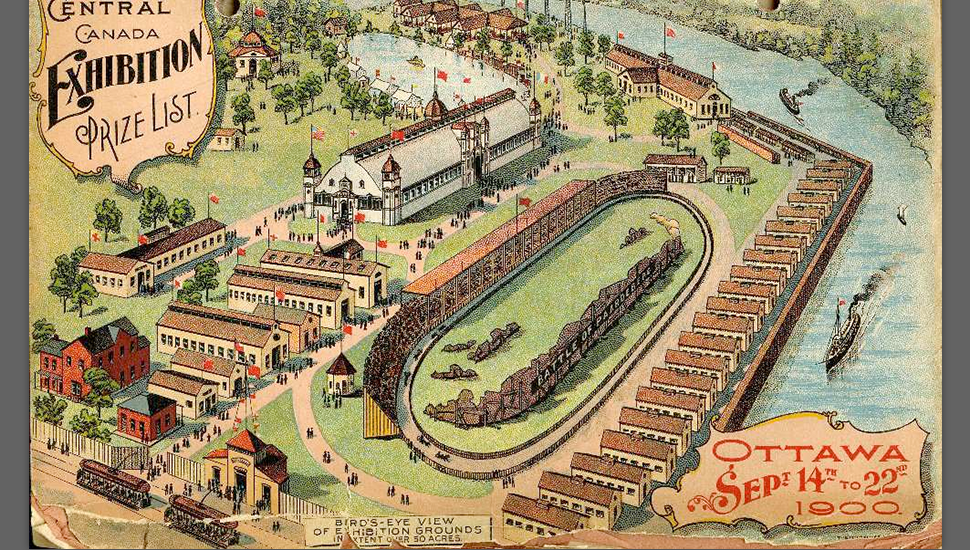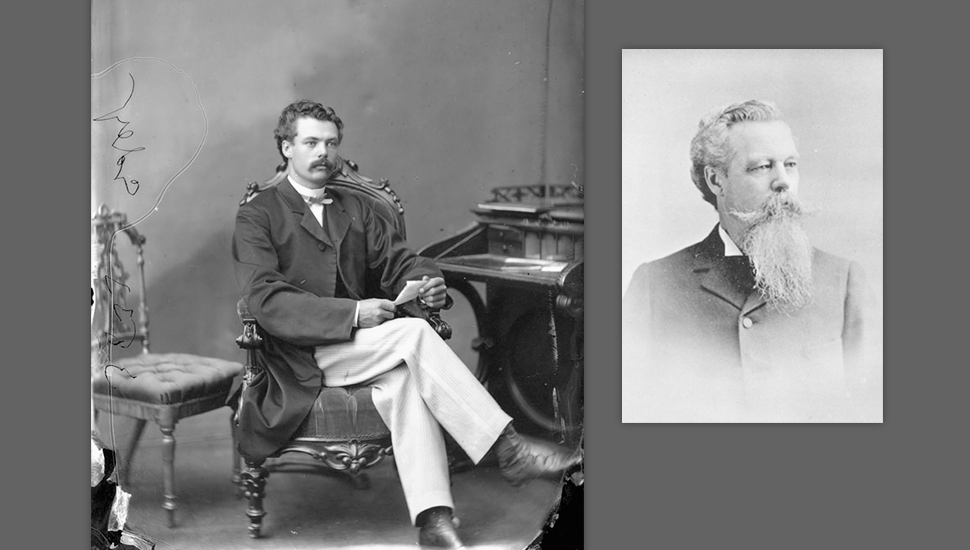50. Aberdeen Pavilion
Construction: 1898 | Restoration: 1993
Architects: Moses Chamberlain Edey | Restoration: Julian Smith & Associates, Architects
Location: 1015 Bank Street, Ottawa
Built in 1898 at Lansdowne Park for the Central Canada Exhibition Association (CCEA), the Aberdeen Pavilion captured the serious purpose of 19th-century agricultural fairs while evoking the festive spirit of a trip to the fairground. It is a rare surviving example in Canada of specialized late-Victorian exhibition halls designed to display agriculture, livestock and manufactured goods.
The design of the Aberdeen Pavilion by Ottawa architect Moses Chamberlain Edey (1845-1919) was in keeping with other grand exhibition halls of the era that were inspired by London’s famous Crystal Palace, built in 1851.
The pavilion was constructed in only two months using lightweight, pre-fabricated steel trusses manufactured by the Dominion Bridge Company of Lachine, Quebec. The grand hall spanned 40 metres in width and reached a height of 22 metres. At 94 metres in length, the Aberdeen Pavilion was the largest column-free space in the city. A gable roofed skylight extended above the entire length of the convex shaped roof. A massive octagonal dome, crowned by a cupola and flagpole, provided the focal point of the design. The classical detail was repeated on the side and end elevations with projecting ornate entrances, large Palladian windows and corner turrets. The whole was clad in rock-face pressed metal and glass, embellished with a whimsical mix of embossed swags, garlands and animal heads pre-fabricated by the Pedlar People Limited manufacturers of Oshawa.
The Aberdeen Pavilion opened to great fanfare in September 1898 with a dedication by Governor General Lord Aberdeen, a staunch supporter of the agricultural fair movement.
Between its opening and the onset of World War I, the Aberdeen Pavilion was used temporarily as a riding school for Lord Strathcona’s Horse before leaving for Pretoria and the Boer War; a skating arena (where the original Ottawa Senators won the Stanley Cup in 1904); and a recruiting centre for Princess Patricia’s Canadian Light Infantry en-route to Valcartier during World War I.
Also known as the Manufacturers’ Building, the Aberdeen Pavilion continued to function as a display hall during the Central Canada Exhibition until September 1939, when Lansdowne Park was taken over by the Department of National Defence for use as a mobilization depot, an army basic training centre and finally a discharge depot.
After the War, the Aberdeen Pavilion resumed operating as an exhibition building for the CCEA when the Central Canada Exhibition was revived in 1947.
In 1972, the CCEA moved the exhibition’s animal showcase to the pavilion, which then became known as the “Cattle Castle.”
In 1973, the CCEA turned the operation of Lansdowne Park over to the City of Ottawa. The City initiated the first of many plans to redevelop the park into a more prominent destination that included proposed new uses for the Aberdeen Pavilion, which by then was suffering from neglect.
In July 1979, the City’s planning board approved LACAC’s recommendation that the Aberdeen Pavilion be designated under Part IV of the Ontario Heritage Act, but City Council voted to withhold designation until a feasibility study could be completed.
In the meantime, support for preserving the Aberdeen Pavilion was growing. In 1983, the Historic Sites and Monuments Board of Canada designated the pavilion a National Historic Site. The City of Ottawa followed by confirming the building’s designation under Part IV of the Ontario Heritage Act in February 1984.
Other proposals to secure a future for the building were bandied about, including converting it into facilities for the Minto Skating Club, but none were realized.
By late 1986 the Aberdeen Pavilion’s condition had deteriorated to such an extent that the building was condemned. It finally closed to the public in October 1987.
What has been described as an “epic battle” to save the landmark structure followed, lasting seven years and multiple votes at City Council.
For a time, the Aberdeen Pavilion’s future seemed secure when its restoration was integrated into a “mega-project” redevelopment of all of Lansdowne Park. But with cost estimates ballooning to $82 million, City Council voted on August 7, 1991 to scrap the entire project and to demolish the heritage-designated Horticulture Building as well as the Aberdeen Pavilion, which by this time had become a visual blight on the landscape.
The timing of the November 1991 municipal election, however, offered a reprieve for both buildings as it was impossible to demolish them before the election.
Heritage Ottawa attracted media attention and maintained public pressure with a number of advocacy activities, including a successful “Hands Around the Aberdeen” demonstration in December 1991. On-site talks and tours, and a public rally in February 1992, garnered the support of hundreds of local citizens who signed a petition destined for City Hall. In June, Heritage Ottawa took the message to local high schools, which translated into a youth-driven “write-in” campaign.
When the newly elected Council convened, then councillors Jim Watson and Peter Hume proposed a scaled-down, simple restoration plan for the Aberdeen Pavilion that would see the building’s exterior restored to its former glory and the unheated interior space made available for community use. The project, budgeted at $5.3 million, was approved by Council in July, 1992.
Conservation architect Julian Smith was appointed to head the project in 1993. Funding was secured from the Parks Canada National Cost Sharing Program, the Ontario Heritage Foundation and the Central Canada Exhibition Association.
The beautifully restored Aberdeen Pavilion was officially re-opened on June 24, 1994 to great ceremony.
Fourteen years later, Council approved a redevelopment plan for Lansdowne Park. The Ottawa Sports and Entertainment Group’s site plan included preserving the Aberdeen Pavilion in situ. The Aberdeen Pavilion was protected by its designation under the Ontario Heritage Act, its status as a National Historic Site, and its heritage easement administered by the Ontario Heritage Trust.
Heritage Ottawa never wavered in its commitment to save the Aberdeen Pavilion from destruction. That commitment is evident in the organization’s decision in 2001 to integrate an illustration of the Aberdeen Pavilion in the organization's logo.
A landmark in Lansdowne Park, the Aberdeen Pavilion remains a testament to Ottawa’s agricultural heritage and a stunning urban showpiece along the historic Rideau Canal, a Unesco World Heritage Site.
UPDATE: November 6, 2023:
Potential Third Tower Overshadows Lansdowne 2.0 / Ottawa Citizen, by Marlo Glass
Lansdowne 2.0 Raises Heritage Concerns / Heritage Ottawa, November 5, 2023





